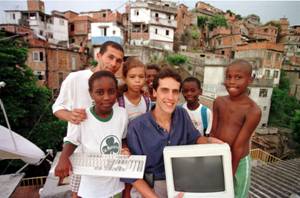
 |
 |
 |
 |
 |
| Organizations Visited | ||
| ATECH |
||
|
CDI |
||
|
Companhia Vale do Rio Doce |
||
|
EDS |
||
|
LNCC |
||
|
NeKi Technologies |
||
|
Petrobras |
||
|
Transax International Limited |
||
|
Universidade Federal do Rio de Janeiro |
||
|
Xerox Brazil |
||
| Rio de Janeiro: Brazil |
 |
||
The Committee for Democracy in Information Technology (CDI) is a non-profit, non-governmental organization that, since 1995, has been pioneering an initiative to promote social inclusion by using information and communication technologies as tools to encourage active citizenship.
CDI implements educational programs in Brazil as well as in 10 other nations on 3 continents through its Information Technology and Citizens Rights Schools, mobilizing excluded segments of society and helping to transform their reality. They work in partnership with low-income community centers and special needs individuals including the visually impaired, mentally disabled, homeless children, prisoners, and indigenous populations. Learning new technologies not only expands job possibilities, but also gives access to knowledge and encourages social interchange. CDI believes this initiative contributes to changing the lives of individuals and has a profound impact on community development.
At the schools students learn how to use computers and software through a socio-educational approach developed by CDI - classes discuss issues of particular interest to their community, such as human rights, environment, sexual education, health and non-violence. Furthermore, the model is based on the concept of helping people help themselves. CDI trains the future teachers of the schools, who, in turn, will train others back in their communities. Each school is an autonomous unit, self-managed and self-sustainable through a symbolic contribution collected from its students. This fund covers the maintenance costs and the payment of instructors in an authentic social enterprise. Presently, there are 833 autonomous and self-sustaining Information Technology and Citizens Rights Schools using CDIs methodology and model concept. As a result of the organization's work, more than 536,900 children and young people have been trained in information technology and introduced to citizens rights.
To start, CDI headquarters staff presented the companys history, mission, goals, teaching philosophies and overall successes. The presenters exhibited a great deal of dedication and spoke very fondly of their work. Whether they were finding computers that could be donated to a school or trying to convince a company to partner with them, the energy level remains the same. The headquarters was somewhat corporate in feel as would be expected from an international organization, but the spirit of giving was inspiring.
The CDI methodology is essentially that of a franchise CDI provides the resources of computers and teacher training but the community must supply the physical space, commitment and drive. Often one person in a community who decides to become a CDI instructor and open a school motivates the rest of the community as they see that success is possible, providing just the role model that is needed. The schools are also designed to be self-sufficient prompting the community to find novel ways to keep it running, such as opening and maintaining a cyber caf or collecting empty print cartridges for recycling.
While enrolled in a course, students learn to be proud of their communities by developing a project of their choosing to be completed using computers. Examples of class projects include creating a local newsletter, compiling the music of artists from the neighborhood, and developing a campaign to help citizens understand recycling. The success of the project depends entirely on the input of the class. These methods increase self-esteem of the students, and it becomes contagious. Soon parents want to get involved with CDI, as do other children who might have been moving in the direction of gangs or drugs. The most telling statistic is that 87% of students believe the courses contribute to a positive change in their lives.
After the presentation, the DePaul class had the opportunity to see a CDI school in session. We drove to one of Rios largest favelas (Portuguese for slum) for an experience none of us will soon forget. Walking uphill with a guard from the neighborhood for protection, we saw extreme poverty and were advised not to take any photographs. The school was set inside a community center where vocational courses like baking were taught. The building was crumbling, but it is one of the few places that community residents feel safe.
Only 5 people could enter the classroom at any one time because it was so small. The rest had the chance to look around the bulletin boards and old bookshelves to get a feel for the reality of the students there. Once inside the classroom, the teacher who was one of the first students ever taught at this school, introduced the class project. The students were all at computers using the Internet for research, typing text in Word, or creating graphics. It was truly amazing to see so many people helping themselves in positive ways through courses taught by CDI.
Related Links
http://www.cdi.org.br/
| Related Links |
|
Pictures http://www.vale.com.br/ |